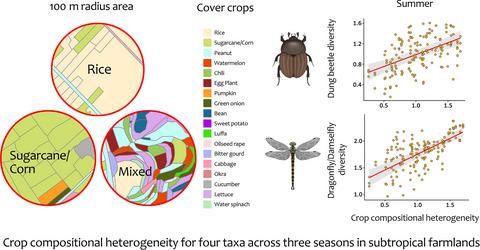当前位置:
X-MOL 学术
›
J. Appl. Ecol.
›
论文详情
Our official English website, www.x-mol.net, welcomes your
feedback! (Note: you will need to create a separate account there.)
Crop heterogeneity is positively associated with beneficial insect diversity in subtropical farmlands
Journal of Applied Ecology ( IF 5.0 ) Pub Date : 2021-08-24 , DOI: 10.1111/1365-2664.14005 Tharaka S. Priyadarshana 1, 2 , Myung‐Bok Lee 3 , John S. Ascher 4 , Lu Qiu 5 , Eben Goodale 1
更新日期:2021-08-24
Journal of Applied Ecology ( IF 5.0 ) Pub Date : 2021-08-24 , DOI: 10.1111/1365-2664.14005 Tharaka S. Priyadarshana 1, 2 , Myung‐Bok Lee 3 , John S. Ascher 4 , Lu Qiu 5 , Eben Goodale 1
Affiliation

|
- Increasing crop configurational heterogeneity—smaller crop fields with more field margins—has been repeatedly found to support farmland biodiversity. But research on compositional crop heterogeneity—the number and evenness of crop types—has usually shown only weak effects. However, much of this research has been conducted in large-scale temperate agroecosystems.
- We examined smallholder subtropical agroecosystems in southern China to assess the effects of crop heterogeneity on beneficial insect biodiversity. In addition to pollinators (bees, apoid and vespid wasps, and butterflies), we studied dung beetles and dragonflies/damselflies, which are not usually considered in cropland heterogeneity studies, but are abundant in these multi-functional agroecosystems. We sampled these taxa in 468 transects placed inside 52 farms across three seasons (summer, spring and winter), collecting data on 27,245 insects belonging to 160 species.
- We found a strong positive effect of crop compositional heterogeneity (measured by Shannon–Wiener index) on dung beetle and dragonfly/damselfly diversity. Bee/wasp and butterfly diversity, conversely, was positively affected by crop configurational heterogeneity (measured by cumulative field margin length).
- Field margin type, categorized by the structure of the dominant crop types, was consistently an important explanatory variable, with weedy margins having high insect diversity. The presence of a vegetable crop on one side of the field margin, compared to non-vegetable monocultures on both sides, increased diversity in 3/4 taxon-season comparisons made for rice and 6/9 comparisons made for sugarcane or corn.
- Synthesis and applications. We demonstrate that crop compositional heterogeneity can support insects that respond to differences among crop types, including taxa that play a key role in nutrient cycling (dung beetles) and natural pest control (dragonflies/damselflies). Incorporating structurally diverse crops into monoculture Asian agroecosystems can reduce the adverse effects these intensive systems have on beneficial insects, and increase crucial ecosystem services.











































 京公网安备 11010802027423号
京公网安备 11010802027423号